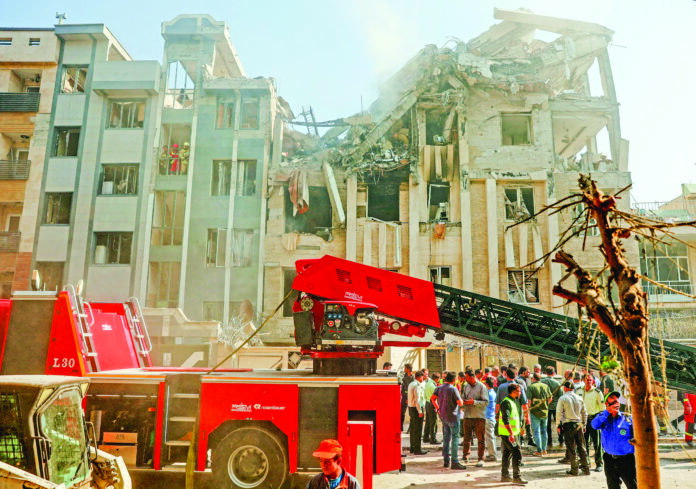
Even with its proxies gone, its military and leadership degraded, Iran still could intensify the missile war against Israel, and strike US and western bases in the region. They could block the Strait of Hormuz and create a global shortage of oil.
PUNE: Israel’s attack on Iran was never a question of “If” but of “When”. The attack was very much anticipated, but its timing took the world, and Iran, by surprise. Iran was in talks with the USA to hammer out a fresh nuclear deal—and the sixth and final round of talks between US and Iranian representatives were scheduled on 15 June. It was widely believed that Israel would attack only after that—if the talks failed. When Israeli jets stuck just after midnight on the night of 13 June, it virtually caught them napping. Israel attacked over 100 targets with a strike package of over 200 aircraft—the largest the IAF had ever assembled since their pre-emptive strike on Egyptian and Syrian air bases in 1967. The attack damaged some of Iran’s most important nuclear installations, missile sites, production facilities and military bases and virtually decapitated their military, political and scientific leadership.
The prime target hit by Israel was Iran’s main uranium enrichment plant at Natanz, “the beating heart of the Iranian nuclear program.” The strike damaged the superstructure and destroyed its electrical system, leading to a massive power outage that damaged the centrifuges where uranium was refined. Parchin, a military complex where nuclear triggers are tested, was also attacked, as were the nuclear sites at Isfahan, Bushehr and the heavy water plant at Arak. Fordow, Iran’s most vital nuclear site which contains the centrifuges essential to create weapon grade uranium was also attacked. But it is located almost half a mile deep in the mountains near Qom, and remained relatively unscathed. That plant will require GBU57 Massive Ordinance Penetrators—a 13-ton monster bomb that can only be delivered by US B2 Bombers. Destruction of this facility will degrade Iran’s weapon making capabilities completely and it is quite likely that the US will get into the fray to deliver the coup de grace.
Purely from a military viewpoint, the attack was indeed quite ingenuously executed. Mossad operatives had infiltrated deep into Iran with drones and high precision munitions, and were already in position in the vicinity of Iranian missile sites and Air Defence systems. (Very akin to the modus operandi, followed by Ukrainians during their attack on Russian airbases.) Iranian AD radars and missiles were attacked from the ground as soon as they opened up to engage Israel aircraft, enabling the aircraft to strike with impunity and compounding the effect. In fact, many of the missiles were targeted as they were transported from storage sites to launch areas, thus degrading the Iranian response.
The pinpoint precision strikes eliminated Major General Hossein Salami, the head of the Iranian Republican Guards Corps, and Major General Bagheri—the chief of staff of Iran’s armed forces. Bagheri’s newly appointed successor was killed just two days later. The head of their missile and space forces was similarly eliminated. Six top nuclear scientists, including the head of Iran’s Atomic Energy Organisation were killed—many of them targeted in their very homes. The decapitating strike killed over 20 of Iran’s top military, political and scientific commanders, precluding any coordinated response.
Targeting Iran—“The head of the snake”—has been on the cards since the 7 October 2023 Hamas attacks. Iran’s nuclear program is seen as an existentialist threat by Israel and the two sides have waged a proxy war for four decades now—ever since the Ayatollahs came into power. But Iran had been systematically weakened over the years. Israel had gradually eliminated all its proxies—Hamas in Gaza, the Hezbollah in Lebanon (whose senior and mid-level leadership were incapacitated by the audacious pager attacks). Even Assad in Syria had been removed from power, and the Houthis were too scattered to make an impact. The two rounds of drone and missile exchanges between Israel and Iran in April and August last year, had exposed the weaknesses and shortcomings of Iran’s Air Defence and rather outdated Air Force. The Israelis identified the gaps in its air cover to perfection and simply swept through them.
Predictably, Iran has responded with salvos of missiles striking Tel Aviv, Jerusalem, Haifa, and other targets deep within Israel. Most of its missiles were intercepted by Israel’s multi-layered air defence system, comprising the much-vaunted Iron Dome, David’s Sling and Arrow interceptors, but the very scale of the attack implied that quite a few projectiles managed to penetrate and get through. Both Israel and Iran have attacked each other’s cities and military installations for over a week now and it is a test of staying power. Iran has an arsenal of around 2,000 to 3,000 missiles—comprising Ghadr, Emad and Shekan series and advanced Fattah and Khorramshahr hypersonic missiles. But its stocks are being rapidly depleted. Israel too, is running out of missile interceptors and the longer the war goes on, the greater will be the vulnerability of both sides.
In spite of US claims that they were not involved, the attack could not have taken place without “a nod and a wink” for Israel to go ahead with the operation. There would also have been promised US support—both diplomatic and military. The US has already moved a third carrier group to the Middle East and its air defence has actively aided Israel in shooting down Iranian missiles. In fact, it is now painting Iran as the aggressor, and not the victim, by its response. Trump claims that there is still time for Iran to make a deal—and has issued veiled threats if they don’t. Curbing Iran’s nuclear ambitions is an article of faith for the Trump administration, and Israel’s action is a convenient way to attain it—and also revamp Middle East and global power equations completely in US favour.
Besides curbing Iran’s nuclear ambitions, one of the aims of this operation is also regime change. Iran supreme leader, the 86-year-old Ayatollah Ali Khamenei was not attacked in the initial strikes and has been whisked away to safety. Trump claims it was on his insistence and has even declared, “We are not going to take him out—at least for now.” But there were hints that he could go the Saddam way, and Iran could just go the Iraq way.
Just as the USA attacked Iraq on the premise that it was producing weapons of mass destruction (something that was later proved false) it has encouraged the attack on Iran to eliminate its nuclear war making potential (which by some estimates are still quite a way off). A regime change is very much on the cards. Pronouncements are circulating that the battle is not against the Iranian people, but their autocratic rulers, and urging Iranians to rise against the oppressive rule of the Ayatollahs. But, if anything, these actions may just unite the Iranian people. Iran—though weakened—is much larger and stronger than Iraq—and it could take a concerted attack by Israel, USA, UK and others—with Pakistan roped in to provide logistics support—to completely reduce its nuclear and military might and engineer a regime change.
But hopefully it will not come to that. Iran may be pressurised to accept a highly loaded nuclear deal and salvage what is left of its nuclear and military power. But even with its proxies gone, its military and leadership degraded, Iran still has quite a few cards up its sleeve. They could intensify the missile war against Israel, and strike US and western bases in the region. They could block the Strait of Hormuz and create a global shortage of oil, impacting world economies. They could also take a harder stance, walk out of the NPT, and actually spur their nuclear weapons’ program with its remaining facilities. The longer this war goes on the greater are the chances of escalation and the fears of it spiralling out of control.
Already the conflict has upended the equations of the Middle East. Iran has been isolated, with not a single country willing to stand up for it—even in the Muslim world. Russia and China are preoccupied with their own problems and unwilling to get involved. And many Arab states, especially Saudi Arabia, Egypt and UAE, are secretly glad at Iran’s loss of influence and stature. There would be some more bloodletting before this round is eventually over. But, irrespective of the eventual outcome, Iran will be severely diminished. The only poles of power in the Middle East will then be Israel and Saudi Arabia—both backed by the US—with no countervailing force to balance them. US influence will edge out China and Russia in the region. And these reshaped power equations hold even greater dangers for the Middle East and the rest of the world.
* Ajay Singh is an international award-winning writer, who has authored seven books and over 200 articles. He writes regularly for The Sunday Guardian.







